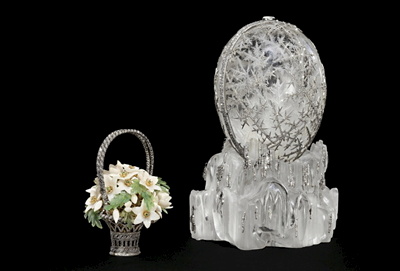Fabergé Eggs, from Revolution to Reinvention
October 09, 25
There are Fabergé eggs, and there are Fabergé eggs.
The originals (there were just 50 of them) were the preserve of Russian royalty. They were the ultimate Easter gift, presented by the tsar to his wife or mother.
Money was no object. They were designed and exquisitely crafted from the finest materials by teams of goldsmiths, jewelers, miniaturists, and mechanics - with a signature surprise (a tiny swan, an intricate clock, a portrait, a moving peacock) inside each egg.
The revolution of 1917 brought that long and expensive tradition to a sudden halt. Members of the Fabergé family fled or were imprisoned by the Bolsheviks. Their equipment, stock, and artworks were confiscated, and their workshops were repurposed to produce munitions for The Great War.
It was more than 70 years before the Fabergé egg was reborn. The modern-day incarnation has, let's say, no more than a loose connection with the original. The Fabergé name was taken without the family's permission by Sam Rubin, an American of Russian descent, for his perfume business (there was subsequently a $25,000 out-of-court-settlement).
The Fabergé name was later bought by cosmetics giant Elizabeth Arden, then by the vast Unilever corporation (where it was used on a wide range of products, including toilet cleaner).
In 1990 it was acquired by German jeweler Victor Mayer, a return, of sorts, to its roots.
That same year the company re-introduced Fabergé eggs as limited-edition items that were expensive (tens of thousands of dollars) but not priceless, like their Russian predecessors.
British gemstone miner acquired Fabergé in 2013 in an all-share deal that valued the company at $142m.
It carried on producing eggs, often with a contemporary twist, such as the James Bond-themed Octopussy egg (decorated with 180 round brilliant cut white diamonds, priced at $145,000) and the 007 Goldfinger Egg Safe Locket with Ruby Heart Surprise for $18,900.
All of which brings us to today and two further landmarks in Fabergé's checkered history. The first is that the company has changed ownership yet again, this time to SMG Capital LLC, a US-based investment firm that specializes in luxury brands.
Gemfields, which reported a net loss of $24.6m for H1 2025, needed working capital to maintain its ruby and emerald mining operations in Mozambique and Zambia.
SMG finalized the $50m deal in August and plans to enhance Fabergé's standing in the global luxury market and expand its international reach. That is likely to include more Fabergé eggs, although that has yet to be confirmed.
Meanwhile, the second landmark is the forthcoming sale, by Christie's London in December, of what is expected to be the world's most expensive Fabergé egg sold at auction.

Pic courtesy Christie's of the Winter Egg
The Winter Egg, carved in 1913 from rock crystal, studded with 1,660 diamonds, and revealing a surprise inside of a platinum basket of carved quartz flowers, is expected to fetch at least $26.9m.
The same egg has already set the world record for a Fabergé egg sold at auction on two previous occasions - selling for $9.1m at Christie's Geneva in 1994, and for $9.6m at Christie's New York in 2002.
The current auction record for Fabergé is held by the 1902 Rothschild Egg, which sold for $11.9m at Christie's London in 2007.
The Rothschild Egg features a diamond-set cockerel that pops up from the top of the egg, flaps its wings four times, nods his head three times, and crows for about fifteen seconds before the clock strikes the hour (a novelty that may prove tiresome after a day or two).
That, in a nutshell (or maybe an egg shell) is a quick history of Fabergé, ancient and modern, from its inception in Saint Petersburg in 1842 to the present.
It is an icon, one that will forever be associated with the opulence of the Russian court. That's the legacy that will guarantee Fabergé's future, no matter how many times it changes hands.
Have a fabulous weekend